-
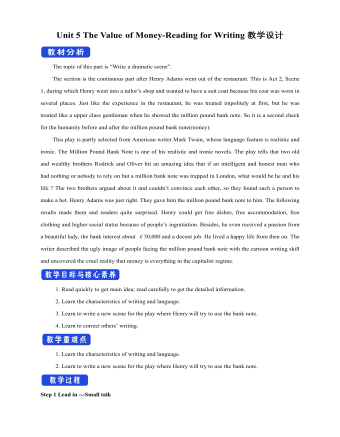
新人教版高中英语必修3Unit 5 The Value of Money-Reading for Writing教学设计二
2. 您能看到, 我头发太长了。You can see that my hair is much too long.3. 无论什么时候, 只要您想回来就回来。Please come back whenever you want.4. 您仅有很少的头发要理! You only have too little hair to cut !5. 为您服务是我的荣幸!It is my honour to serve you!Step 9 Writing(Henry is walking down the street when he sees a sign for a place that cuts hair. He decides to have it cut. )H=Henry B=BarberH: Good afternoon, I’d like to have my hair cut, if I may. (The barber looks at Henry’s hair and continues cutting another man’s hair. ) Er, I’d really like a haircut. As you can see it’s much too long. B: (in a rude manner) Yes, I can see that. Indeed, I can. H: Fine, well, I’ll have a seat then. (He sits in one of the barber’s chairs. The barber turns to look at Henry. )B: It’s quite expensive here, you know! Are you sure you can afford it?H: Yes. I think so. (After his hair is cut, the barber tells Henry how much he must pay. Henry shows the barber the bank note. )B: Why Mr. . . (looks shocked)H: Adams. Henry Adams. I’m sorry. I don’t have any change. B: Please don’t worry! (wearing a big smile) Nothing to worry about! Nothing at all! Please come back whenever you want, even if you only have too little hair to cut! It will be my honour to serve you!Step 10 Pair workExchange drafts with a partner. Use this checklist to help your partner revise his/her draft.1. Are all the elements of a play included and in good order ?2. Do the character use suitable language ?3. Are the stage directions clear and useful ?4. Is the plot clear and exciting enough ?
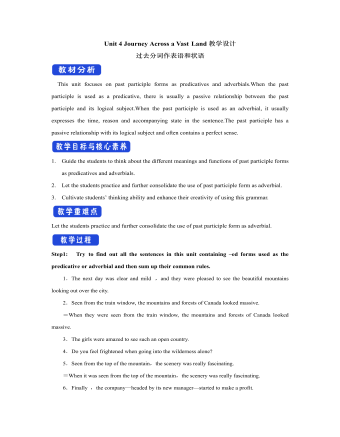
新人教版高中英语选修2Unit 4 Journey Across a Vast Land教学设计
当孩子们由父母陪同时,他们才被允许进入这个运动场。3.过去分词(短语)作状语时的几种特殊情况(1)过去分词(短语)在句中作时间、条件、原因、让步状语时,相当于对应的时间、条件、原因及让步状语从句。Seen from the top of the mountain (=When it is seen from the top of the mountain), the whole town looks more beautiful.从山顶上看,整个城市看起来更美了。Given ten more minutes (=If we are given ten more minutes), we will finish the work perfectly.如果多给十分钟,我们会完美地完成这项工作。Greatly touched by his words (=Because she was greatly touched by his words), she was full of tears.由于被他的话深深地感动,她满眼泪花。Warned of the storm (=Though they were warned of the storm), the farmers were still working on the farm.尽管被警告了风暴的到来,但农民们仍在农场干活。(2)过去分词(短语)在句中作伴随、方式等状语时,可改为句子的并列谓语或改为并列分句。The teacher came into the room, followed by two students (=and was followed by two students).后面跟着两个学生,老师走进了房间。He spent the whole afternoon, accompanied by his mom(=and was accompanied by his mom).他由母亲陪着度过了一整个下午。

新人教版高中英语选修2Unit 1 Science and Scientists-Reading and thinking教学设计
Step 5: After learning the text, discuss with your peers about the following questions:1.John Snow believed Idea 2 was right. How did he finally prove it?2. Do you think John Snow would have solved this problem without the map?3. Cholera is a 19th century disease. What disease do you think is similar to cholera today?SARS and Covid-19 because they are both deadly and fatally infectious, have an unknown cause and need serious public health care to solve them urgently.keys:1. John Snow finally proved his idea because he found an outbreak that was clearly related to cholera, collected information and was able to tie cases outside the area to the polluted water.2. No. The map helped John Snow organize his ideas. He was able to identify those households that had had many deaths and check their water-drinking habits. He identified those houses that had had no deaths and surveyed their drinking habits. The evidence clearly pointed to the polluted water being the cause.3. SARS and Covid-19 because they are both deadly and fatally infectious, have an unknown cause and need serious public health care to solve them urgently.Step 6: Consolidate what you have learned by filling in the blanks:John Snow was a well-known _1___ in London in the _2__ century. He wanted to find the _3_____ of cholera in order to help people ___4_____ it. In 1854 when a cholera __5__ London, he began to gather information. He ___6__ on a map ___7___ all the dead people had lived and he found that many people who had ___8____ (drink) the dirty water from the __9____ died. So he decided that the polluted water ___10____ cholera. He suggested that the ___11__ of all water supplies should be _12______ and new methods of dealing with ____13___ water be found. Finally, “King Cholera” was __14_____.Keys: 1. doctor 2. 19th 3.cause 4.infected with 5.hit 6.marked 7.where 8.drunk 9.pump 10.carried 11.source 12.examined 13.polluted 14.defeatedHomework: Retell the text after class and preview its language points

新人教版高中英语选修2Unit 1 Science and Scientists-Using langauge教学设计
This happens because the dish soap molecules have a strong negative charge, and the milk molecules have a strong positive charge. Like magnets, these molecules are attracted to each other, and so they appear to move around on the plate, taking the food coloring with them, making it look like the colors are quickly moving to escape from the soap.Listening text:? Judy: Oh, I'm so sorry that you were ill and couldn't come with us on our field trip. How are you feeling now? Better?? Bill: Much better, thanks. But how was it?? Judy: Wonderful! I especially liked an area of the museum called Light Games.it was really cool. They had a hall of mirrors where I could see myself reflected thousands of times!? Bill: A hall of mirrors can be a lot of fun. What else did they have?? Judy: Well, they had an experiment where we looked at a blue screen for a while, and then suddenly we could see tiny bright lights moving around on it. You'll never guess what those bright lights were!? Bill: Come on, tell me!? Judy: They were our own blood cells. For some reason, our eyes play tricks on us when we look at a blue screen, and we can see our own blood cells moving around like little lights! But there was another thing I liked better. I stood in front of a white light, and it cast different shadows of me in every color of the rainbow!? Bill: Oh, I wish I had been there. Tell me more!? Judy: Well, they had another area for sound. They had a giant piano keyboard that you could use your feet to play. But then, instead of playing the sounds of a piano, it played the voices of classical singers! Then they had a giant dish, and when you spoke into it, it reflected the sound back and made it louder. You could use it to speak in a whisper to someone 17 meters away.? Bill: It all sounds so cool. I wish I could have gone with you? Judy: I know, but we can go together this weekend. I'd love to go there again!? Bill: That sounds like a great idea!

新人教版高中英语选修2Unit 2 Bridging Cultures-Discovering useful structures教学设计
The grammar of this unit is designed to review noun clauses. Sentences that use nouns in a sentence are called noun clauses. Nominal clauses can act as subject, object, predicate, appositive and other components in compound sentences. According to the above-mentioned different grammatical functions, nominal clauses are divided into subject clause, object clause, predicate clause and appositive clause. In this unit, we will review the three kinds of nominal clauses. Appositive clauses are not required to be mastered in the optional compulsory stage, so they are not involved.1. Guide the students to judge the compound sentences and determine the composition of the clauses in the sentence.2. Instruct students to try to learn grammar by generalizing grammar rules, controlling written practice, and semi-open oral output.3. Inspire the students to systematize the function and usage of noun clause1.Instruct students to try to learn grammar by generalizing grammar rules, controlling written practice, and semi-open oral output.2.Inspire the students to systematize the function and usage of noun clauseStep1: The teacher ask studetns to find out more nominal clauses from the reading passage and udnerline the nominal clauses.

新人教版高中英语选修2Unit 3 Food and Culture-Discovering useful structures教学设计
The newspaper reported more than 100 people had been killed in the thunderstorm.报纸报道说有一百多人在暴风雨中丧生。(2)before、when、by the time、until、after、once等引导的时间状语从句的谓语是一般过去时,以及by、before后面接过去的时间时,主句动作发生在从句的动作或过去的时间之前且表示被动时,要用过去完成时的被动语态。By the time my brother was 10, he had been sent to Italy.我弟弟10岁前就已经被送到意大利了。Tons of rice had been produced by the end of last month. 到上月底已生产了好几吨大米。(3) It was the first/second/last ... time that ...句中that引导的定语从句中,主语与谓语构成被动关系时,要用过去完成时的被动语态。It was the first time that I had seen the night fact to face in one and a half years. 这是我一年半以来第一次亲眼目睹夜晚的景色。(4)在虚拟语气中,条件句表示与过去事实相反,且主语与谓语构成被动关系时,要用过去完成时的被动语态。If I had been instructed by him earlier, I would have finished the task.如果我早一点得到他的指示,我早就完成这项任务了。If I had hurried, I wouldn't have missed the train.如果我快点的话,我就不会误了火车。If you had been at the party, you would have met him. 如果你去了晚会,你就会见到他的。
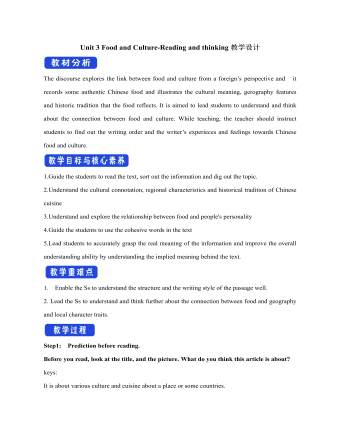
新人教版高中英语选修2Unit 3 Food and Culture-Reading and thinking教学设计
The discourse explores the link between food and culture from a foreign’s perspective and it records some authentic Chinese food and illustrates the cultural meaning, gerography features and historic tradition that the food reflects. It is aimed to lead students to understand and think about the connection between food and culture. While teaching, the teacher should instruct students to find out the writing order and the writer’s experieces and feelings towards Chinese food and culture.1.Guide the students to read the text, sort out the information and dig out the topic.2.Understand the cultural connotation, regional characteristics and historical tradition of Chinese cuisine3.Understand and explore the relationship between food and people's personality4.Guide the students to use the cohesive words in the text5.Lead students to accurately grasp the real meaning of the information and improve the overall understanding ability by understanding the implied meaning behind the text.1. Enable the Ss to understand the structure and the writing style of the passage well.2. Lead the Ss to understand and think further about the connection between food and geography and local character traits.Step1: Prediction before reading. Before you read, look at the title, and the picture. What do you think this article is about?keys:It is about various culture and cuisine about a place or some countries.
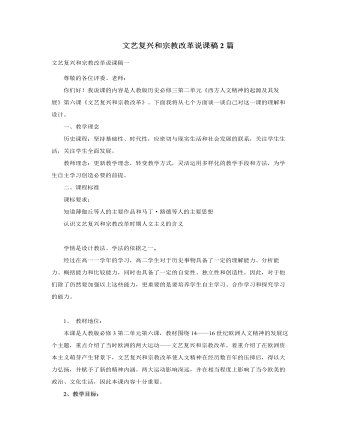
人教版高中历史必修3文艺复兴和宗教改革说课稿2篇
师:在科学发展过程中,前一个理论体系的不完善之处,往往是新的研究和新的发现的突破口。开普勒之后,意大利天文学家伽利略创制了天文望远镜,用更加精确的观察继续发展和验证哥白尼创立的新天文学理论。除了用望远镜进行天文观察以外,伽利略还开始进行自然科学的实验研究,哪位同学能给大家讲一讲伽利略在比萨斜塔上所作的关于物体自由下落的实验?生:(讲述这一实验)师:所以,伽利略在科学方面更加重要的贡献是奠定了近代实验科学的基础。(2)实验科学和唯物主义师:伽利略从实践上开辟了实验科学的方法,而英国唯物主义哲学家培根则从理论上阐述了实验科学的方法——归纳法。培根和伽利略同被称为实验科学之父,培根还有一句影响深刻的名言:“知识就是力量”,表明了他注重知识,尊崇科学的精神。我们再来概括一下意大利哲学家布鲁诺的唯物主义思想,是否有同学可以简述布鲁诺的生平事迹?
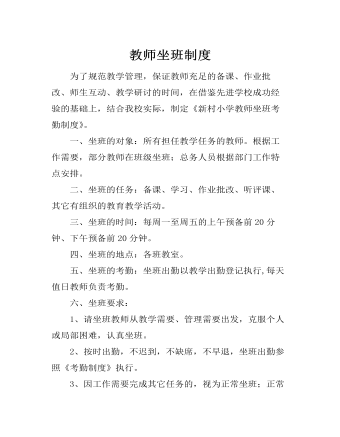
教师坐班制度
二、坐班的任务:备课、学习、作业批改、听评课、其它有组织的教育教学活动。 三、坐班的时间:每周一至周五的上午预备前20分钟、下午预备前20分钟。 四、坐班的地点:各班教室。 五、坐班的考勤:坐班出勤以教学出勤登记执行,每天值日教师负责考勤。 六、坐班要求: 1、请坐班教师从教学需要、管理需要出发,克服个人或局部困难,认真坐班。
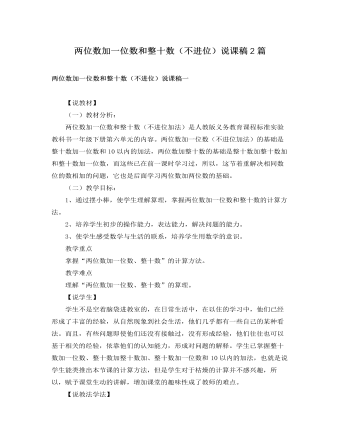
人教版新课标小学数学一年级下册两位数加一位数和整十数(不进位)说课稿2篇
(二)创设情境,探索新知。1、创设情境,激发兴趣。小白兔和小熊要坐公交车去公园,他们来到公交公司,先后看到公交公司有一边说一边课件出示课件,请同学们仔细观察,把你从图上看到的物品和读出的数据告诉老师和其他同学。你能根据这些信息提出不同的数学问题吗?再从同学们提出的众多问题中选择两个具有代表性的问题来列式和计算。课件出示主题图下列两个问题:指名说出两个问题的算式分别是什么,明确45 + 30和45 + 3是两位数加一位数和两位数加整十数的加法算式,引出课题——两位数加一位数和整十数(不进位)这一层次从学生熟悉的生活情境出发,选择学生熟悉的旅游,让学生自己发现、提出有关的数学问题,从而主动的解决问题。这里通过创造出生动的生活情境来提取例题,符合学生的年龄、认知特征,既激发了学生的学习兴趣,又使学生感受到数学与生活的密切联系,容易为学生所感知,所接受。
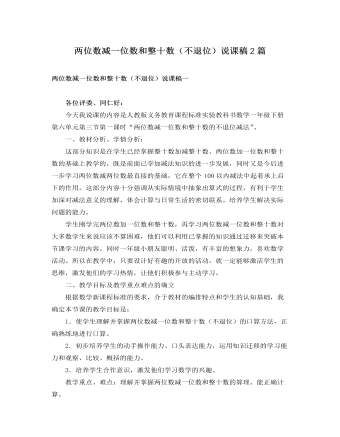
人教版新课标小学数学一年级下册两位数减一位数和整十数(不退位)说课稿2篇
3、教学目标及教学重点难点根据课标的要求,介于教材的特点和学生实际,我确定本节课的教学目标是:(1)、知识与技能:让学生经历探索两位数减一位数和整十数(不退位)的计算方法的过程,掌握计算方法,能正确地口算。(2)、过程与方法:让学生经历自主探索、动手操作、合作交流等方式获得新知的过程,积累数学活动的经验,体会数学知识与日常生活的密切联系,增强应用意识。 (3)、情感态度与价值观:进一步培养学生学习数学的热情,以及积极思考、动手实践并与同学合作学习的态度。其中,掌握两位数减一位数和整十数(不退位)的口算方法是重点,理解算理,把握两位数减一位数与两位数减整十数在计算过程中的相同点与不同点是难点。
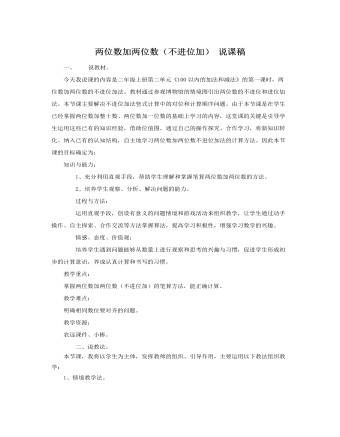
人教版新课标小学数学二年级上册两位数加两位数(不进位加) 说课稿
今天我说课的内容是二年级上册第二单元《100以内的加法和减法》的第一课时,两位数加两位数的不进位加法。教材通过参观博物馆的情境图引出两位数的不进位和进位加法。本节课主要解决不进位加法竖式计算中的对位和计算顺序问题。由于本节课是在学生已经掌握两位数加整十数、两位数加一位数的基础上学习的内容,这堂课的关键是引导学生运用这些已有的知识经验,借助位值图,通过自己的操作探究、合作学习,将新知识转化、纳入已有的认知结构,自主地学习两位数加两位数不进位加法的计算方法。因此本节课的目标确定为:知识与能力:1、充分利用直观手段,帮助学生理解和掌握笔算两位数加两位数的方法。2、培养学生观察、分析、解决问题的能力。过程与方法:运用直观手段,创设有意义的问题情境和游戏活动来组织教学,让学生通过动手操作、自主探索、合作交流等方法掌握算法,提高学习积极性,增强学习数学的兴趣。
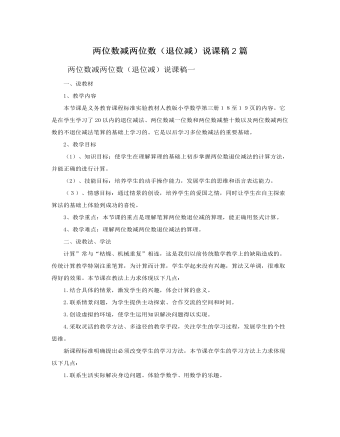
人教版新课标小学数学二年级上册两位数减两位数(退位减)说课稿2篇
一、说教材1、教学内容本节课是义务教育课程标准实验教材人教版小学数学第三册18至19页的内容。它是在学生学习了20以内的退位减法、两位数减一位数和两位数减整十数以及两位数减两位数的不退位减法笔算的基础上学习的。它是以后学习多位数减法的重要基础。2、教学目标(1)、知识目标:使学生在理解算理的基础上初步掌握两位数退位减法的计算方法,并能正确的进行计算。(2)、技能目标:培养学生的动手操作能力,发展学生的思维和语言表达能力。(3)、情感目标:通过情景的创设,培养学生的爱国之情,同时让学生在自主探索算法的基础上体验到成功的喜悦。3、教学重点:本节课的重点是理解笔算两位数退位减的算理,能正确用竖式计算。4、教学难点:理解两位数减两位数退位减法的算理。
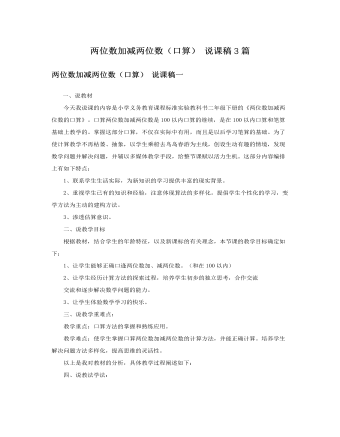
人教版新课标小学数学二年级下册两位数加减两位数(口算)说课稿3篇
二、说教学目标1、结合具体情境进一步理解加减法的意义,能正确口算得数是百以内数的两位数加减法。2、能利用所学知识,在教师的指导下提出并解决简单的实际问题,了解同一问题可以用不同的方法解决。3、经历与他人交流各自计算方法的过程,体验解决问题策略的多样性,感受学数学、用数学的乐趣。三、说教法、学法教法:为了使学生掌握好百以内的两位数加减两位数的口算这部分知识,达到以上教学目的,突破以上教学重难点,我采用了迁移法、引导法、讲解法、联系法、自主探索法来进行教学。学法:通过本课的学习,使学生学会利用旧知构建新知的方法、合作探究的方法,调动学生主动探索的积极性。四、说教学过程(一)创设情景、导入新课1、谈话:同学们,大千世界无奇不有。我们所处的人类的社会是由一个个担任不同工作的人所组成的,而和我们生活密切相关的蜜蜂也跟人类一样,它们生活在一个蜜蜂王国里,今天我们就一起到那里了解一下蜜蜂的生活吧。
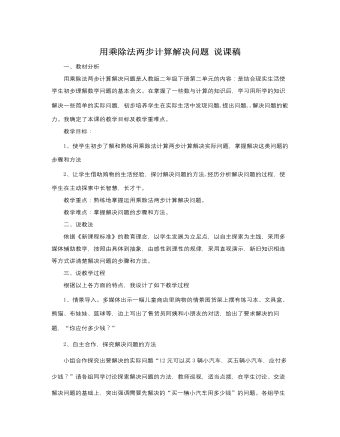
人教版新课标小学数学二年级下册用乘除法两步计算解决问题说课稿
例2是面包房买卖面包的情境。解决问题的重点是学会使用小括号列综合算式,并了解小括号的作用。通过学生熟悉的购买面包的情境,解决“还剩多少个”这个实际问题。仍然可以引导学生从不同的角度思考问题,启发列式为54-8-22或为54-(8+22)。第二种解法的综合算式,教材中特别强调“如果写成一个算式,应该使用小括号”,并明确“计算时先算小括号里面的”。因为是初次在列式时需要使用小括号,如果学生产生疑问,教师可组织学生通过回顾旧知,利用现实情境,明确使用小括号的必要性及使用方法。教学例2时可以采用与例1相似的教学方式。首先让学生观察下页图,也可以利用电教媒体创设情境,由学生提出问题,并启发学生思考如何解决。让学生充分交流研讨,畅谈自己的想法,然后着重说明解决问题的思路。列式计算时可以先分步列式,同时强调两种列式方法的内在联系,列综合算式时着重说明使用小括号的目的。
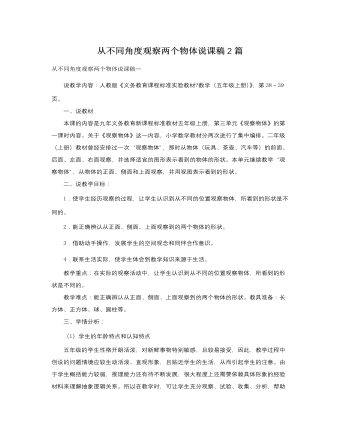
人教版新课标小学数学五年级上册从不同角度观察两个物体说课稿2篇
自主探究法:教学中强调以学生为主体,强调学生参与知识的形成过程,始终做到为学生提供充足的学习素材、创设充分学习的空间、时间,让学生自主探究,体验知识形成的过程,培养主动探究的能力。观察法:例1观察物体教学中的观察是很好的学习方法。例如,教学例1时,观察目的明确。教师通过让学生观察长方体物体学会从不同角度观察物体的方法。这一安排不仅给学生独立思考的机会,而且教给学生观察的思维方法。四、说教学程序在提出问题中,引发学生思考;在自主探索中,激发学生创新思维;在展示交流中,感受学生的个性;在总结陈述中,体验成功的乐趣;在联想记忆中进一步发挥学生的创造才能。在设计这节课时,我在尊重教材的基础上,力求体现新课标的新理念、新思想,导学案中设计了以下几个教学环节:
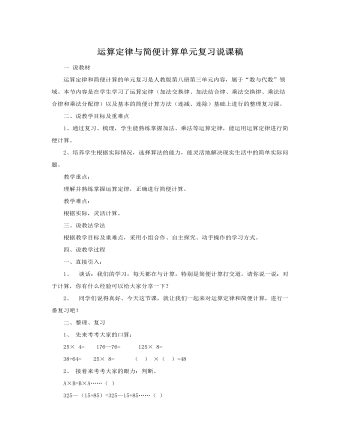
人教版新课标小学数学四年级下册运算定律与简便计算单元复习说课稿
一 说教材运算定律和简便计算的单元复习是人教版第八册第三单元内容,属于“数与代数”领域。本节内容是在学生学习了运算定律(加法交换律、加法结合律、乘法交换律、乘法结合律和乘法分配律)以及基本的简便计算方法(连减、连除)基础上进行的整理复习课。二、说教学目标及重难点1、通过复习、梳理,学生能熟练掌握加法、乘法等运算定律,能运用运算定律进行简便计算。2、培养学生根据实际情况,选择算法的能力,能灵活地解决现实生活中的简单实际问题。教学重点:理解并熟练掌握运算定律,正确进行简便计算。教学难点:根据实际,灵活计算。三、说教法学法根据教学目标及重难点,采用小组合作、自主探究、动手操作的学习方式。四、说教学过程

人教版新课标小学数学四年级下册小数点位置移动引起小数大小变化说课稿
4、实际生活中的应用。提问学生:小数点位置移动引起小数大小的变化这规律在学习和生活有什么应用?(让学生思考在学习中,点错小数点的位置,小数的大小就不一样了。如果在银行统计时点错右漏写小数点会怎样?)教育学生做事认真细心。(四)小结质疑,自我评价这节课我们学习了什么?小数点位置移动引起小数大小的变化规律是怎样的?质疑:对今天的学习还有什么疑问吗?(培养学生敢于质疑,勇于创新的精神)评价:首先自评,学生对自己学得怎样,用什么方法学习,印象最深的内容是什么进行评介。接着可以生生互评或师生互评,教师重点表扬大部分学得好的同学或全班的同学,增强学生的自信心和荣誉感,使他们更加热爱数学。(五)作业布置:1、回忆一遍操作探索发现规律的整个过程,进一步培养学生良好的学习方法和习惯。2、预习97页,例2和例3,做书上98页练习第三题。
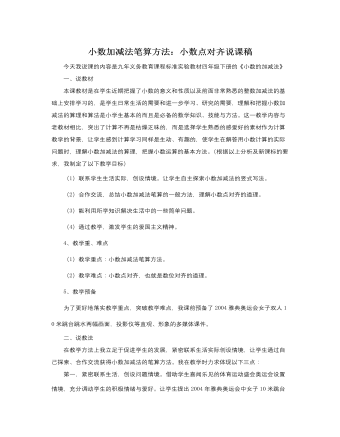
人教版新课标小学数学四年级下册小数加减法笔算方法:小数点对齐说课稿
(4)验算师:小数加减计算很轻易出错,你有什么方法检验计算的结果?(假如有困难,教师再提示一下)(三)巩固应用、内化提高 刚才的学生刚刚体会到了成功的喜悦,在此基础上,我安排了三个层次的练习。1. 基本练习,出几道直接写得数的一位小数加减法的题,让学生掌握本课的基础知识。2. 综合练习,是课后做一做1,巩固新知识,发展学生思维的机智性与灵活性。3. 提高练习,课后做一做2这是小数加减法的两步应用题,这样既培养了学生运用知识的能力,有培养了学生的创新能力。【设计意图】这样的练习的设计有密度,有坡度,形式多样,而且具有层次性。不仅巩固了学生的计算能力,而且还培养了学生的应用能力。在这个环节中,还让学生开展了自我评价、生生互评等。大大提高了学生学习的积极性。(四)回顾整理,反思提升通过今天的学习,你都有哪些收获?
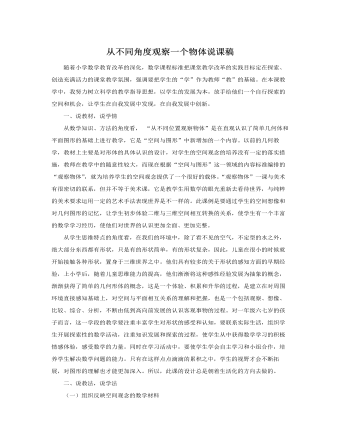
人教版新课标小学数学五年级上册从不同角度观察一个物体说课稿
(三)实践性数学是一种工具,一种将自然、社会运动现象法则化、简约化的工具。数学学习的最重要的成果就是学会建立数学模型,用以解决实际问题。因此,在这节课中,大量地创设条件,让学生把课堂中所学的知识和方法应用于生活实际之中,“学以致用”,让学生切实感受到生活中处处有数学。如上课伊始的猜冰箱,课中观察玩具、用品,给熊猫照相等,都采用了贴近学生生活的材料,旨在联系生活,开阔视野,同时延伸学习,使学生能从看到的物体的某一个面,联想到整个物体的形状,培养其观察立体实物的能力,建立初步的空间观念,发展形象思维。本课的所有教学环节都注重借助学生生活中常见的事物为知识载体,意在让学生感悟到“数学就在我们身边,生活离不开数学”。二、需进一步探究的问题“观察物体”的内容主要是对简单物体正面、侧面、上面形状的观察,因此本节课选择了大量生活中的实物让学生观察,旨在培养学生的空间观念。